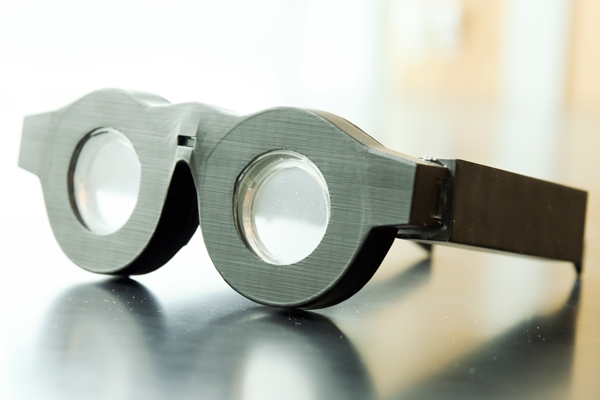26 January 2017. An engineering lab at University of Utah developed a system with eyeglass lenses that automatically adjust to the focus of the wearer, to replace bifocals and reading glasses. A team led by electrical engineering professor Carlos Mastrangelo describe the prototype device in the 17 January issue of the journal Optics Express.
Mastrangelo and colleagues are seeking a more convenient solution for people as they reach middle age and beyond, when problems develop with focusing on objects close-up, a condition known as presbyopia or farsightedness. For people with the condition, the eye’s natural lens hardens, making it difficult to focus light directly on the retina, coupled with weaker muscle fibers around the retina. As a result, light tends to focus behind the retina, causing poor vision for close-up objects.
Because presbyopia is so common, most people with the condition can choose from multiple solutions for dealing with it, such as reading glasses, prescription eyeglasses, contact lenses, and laser surgery. Each of these options has its advantages and disadvantages, and people seeking ways to correct presbyopia need to balance factors of effectiveness, convenience, and cost.
The Utah team addresses one of those factors, convenience. Reading glasses are a simple and inexpensive option for people with no other vision disorders, but they need to be put on and taken off as needed. For some situations, like driving, putting on and removing glasses can pose risks. In addition, as some people age, their vision degrades further, requiring new glasses with more powerful lenses.
The system developed by the researchers has eyeglass lenses that adjust automatically to the object being viewed. “Most people who get reading glasses have to put them on and take them off all the time,” says Mastrangelo in a university statement. ““You don’t have to do that anymore. You put these on, and it’s always clear.”
The team’s prototype uses lenses filled with glycerin, a clear, thick viscous liquid. The lenses are mounted in eyeglass frames that in their current design look more like goggles, and are held in the frames by flexible membranes in front and rear. The lenses are adjusted with three levers connected to the rear membranes that push the lenses back and forth like pistons. But the mechanism also changes the curvature of the lenses, and thus the focal length between the lenses and eyes.
Thick frames are needed to hold the electronics controlling the device and battery providing the power. In the bridge of the frames is a meter that measures distance to the object with an infrared beam. The meter calculates distance to the object, which then adjusts the curvature of the lenses to the correct focal length to provide a clear view of the object.
Before wearing the glasses for the first time, the user needs to calibrate the lenses for his or her prescription, which is done with a smartphone app written for the device that connects to the frame via Bluetooth signals. No further calibrations are needed unless the user’s prescription changes, which can be entered again through the app. The original frames and lenses would not need to be changed.
The researchers tested the prototype system in the lab, with the lenses adjusting to objects, in this case text on a page, at varying distances, documented by photos of the texts. The team says the device draws little power, and can operate with lightweight rechargeable batteries for about 6 hours.
The team demonstrated the system at the recent Consumer Electronics Show in Las Vegas, but admits that the design needs to be made lighter and smaller. The university says Sharpeyes LLC, a start-up company, plans to take the system to market.
The following brief (30 second) video demonstrates the lenses adjusting to varying differences.
- Wearable Health Devices Offer Early Disease Detection
- Wearable Device Senses Environment for Sight Impaired
- Solar Cells Shown Feasible to Power Medical Implants
- Smartphone System Shown to Control Blood Glucose Levels
- RTI, Validic to Boost Wearable Health Data Value
* * *


 RSS - Posts
RSS - Posts
You must be logged in to post a comment.